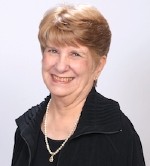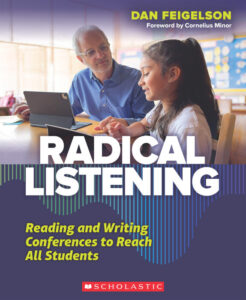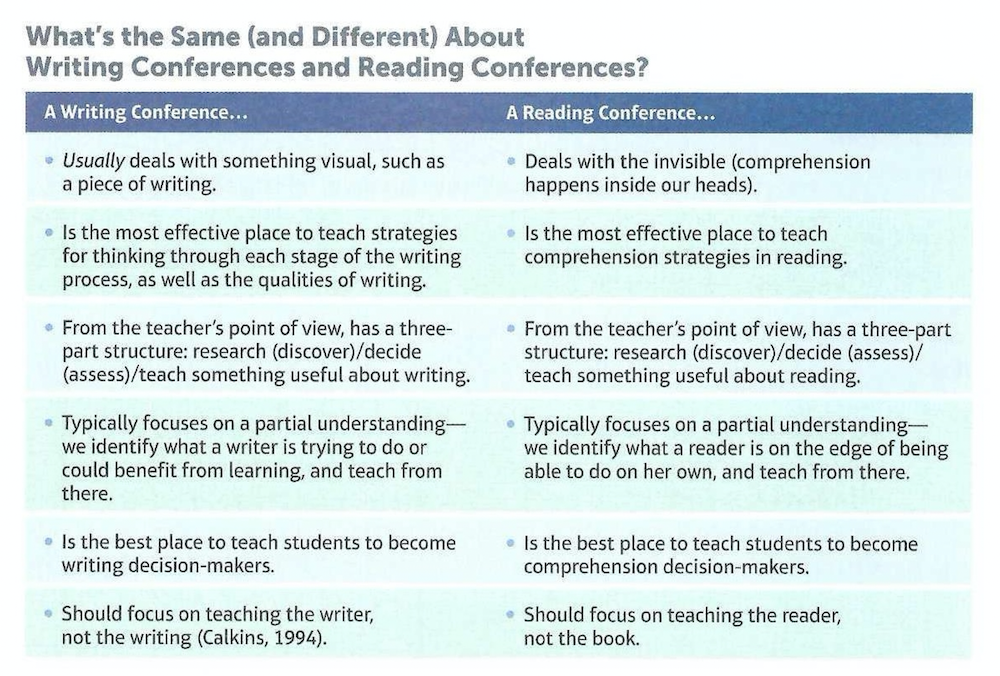Literacy Conferences to Reach All Students
Radical Listening: Reading and Writing Conferences to Reach All Students
By Dan Feigelson
(Scholastic Inc., 2022 – Learn more)
Reviewed by Anne Anderson

That’s what Feigelson does throughout his book. He shares stories, step-by-step ideas for how to listen, and how to extend student learning.
According to Feigelson, the key to conferring successfully is listening to children. Here are Feigelson’s Four Principles of Listening Reading and Writing Conferences:
1. Concentrate on learning before you worry about teaching.
2. Be curious. Ask questions.
3. Listen for the strength, not the deficit.
4. Listen for the general in the specific.

Readers can also find great advice for dealing with the pressures of standards, curriculum, and assessments. Readers will likely see themselves or their students in this book.
The author’s suggestions are practical and should be easy to implement. Here’s one example from page 17: “A general rule of thumb is to listen for the most interesting parts of what a student says, and ask her to ‘say more about that’ at least three times before leaping in with teacher content.”
Chapter 2 addresses Conferring Basics. This chart from page 25 gives teachers a quick view of the similarities and differences between reading and writing conferences.

- Competency 1: Content Knowledge
- Competency 2: Diagnostic Listening
- Competency 3: Structure, Sequence, and Pacing
Following the explanation of these competencies, teachers will find a rubric to support their growth and change.
In Chapter Three, Individual Reading Conferences, the author begins with some basic reminders about teaching reading. He includes a cheat sheet summarizing some of the content of comprehension. He continues to provide guidance with his Steps in a Reading Conference chart. “These steps and their order are not set in stone, by any means.” (p. 42)
Take time to carefully read Conference with Amari (pp. 43-46). The transcript of the reading conference between Feigelson and this second grader, along with the author’s personal notes and comments provide the reader some excellent, up-close, and personal professional development. He even suggests a Professional Development/Grade-Meeting Activity to help teachers grow as listeners.
This chapter is filled with strategies and suggestions along with a partial transcript of his conversation with a fifth-grader. After reading this chapter, Consider the Opposite is my new favorite activity! It may well become one of your favorites.
Similarly, Chapter Four, Individual Writing Conferences, begins with some basic reminders about teaching writing. Feigelson suggests that writing conferences fall into these four general groups:
- Structure/Organization
- Focus/Detail/Elaboration
- Craft/Voice
- Conventions
As with reading, the author created a Cheat Sheet for Conferring based on the Qualities of Writing and Stages of the Writing Cycle. A chart, Steps in a Writing Conference, provides guidance.
“Asking young writers to reflect on their thinking in a nonjudgmental way signals confidence in their ability to explain – and an interest in what they have to say.” (p. 104) By studying the transcripts of the writing conferences, readers can become more confident. This chapter is rich in strategies that readers will want to include in their repertoire.
Looking for ways to join reading and writing? That’s addressed in Chapter 5, Connecting Reading and Writing Conferences. The author proposes two options:
- “to address parallel teaching points across reading and writing conferences
- to address reading and writing teaching points in the same conference.” (p. 140)
As Dan Feigelson closes, readers are reminded why we do what we do. “This is not a book about curriculum. But it is not a book against curriculum either. Rather, it is a plea for balance between the need for teaching specific content and the need to honor the spark in every student, of every background, in schools all over the world.” (p. 159)
Add this book to your professional library. Add these strategies and suggestions to your teacher toolbox. Then celebrate as you watch what happens in your classroom.
Videos and downloadable files are available from Scholastic.
Anne Anderson always knew she wanted to be a teacher. She graduated from East Texas Baptist University with an English major and History minor and did graduate work at Louisiana State University and Louisiana Tech University. After teaching 8th graders for 24 years, Anne served as a content coach. Since retiring in 2011, Anne has worked as an educational consultant, presenting at national conferences and onsite trainings for public and private schools.
Calendar Celebrations: September, October, November is part of Anne Anderson’s trilogy on resources for months of the school year. (For MiddleWeb she wrote about selected fall celebrations here, about spring here and about winter here.) Anne has also published articles in IDEAS Plus and Voices from the Middle, publications of the National Council of Teachers of English. She is a frequent reviewer of professional books for MiddleWeb.com.































